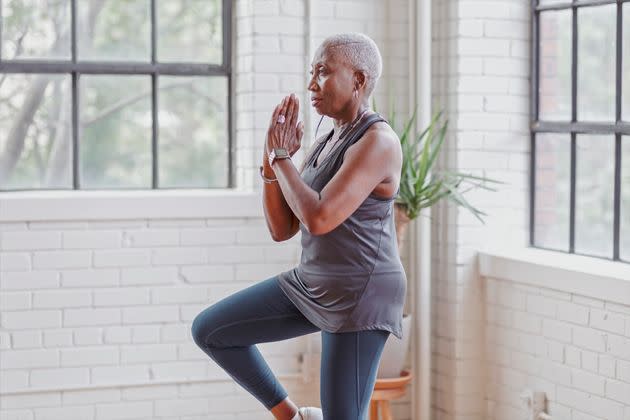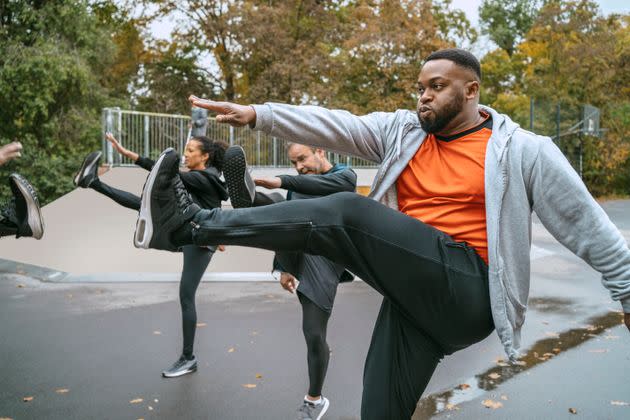8 Things Knee Doctors Say You Should Never, Ever Do

People often forget what a big role knees play in mobility and everyday life ― until they start to hurt.
Knee pain and injuries are fairly common, especially as we age. And although knee replacements can be a big help to people dealing with serious mobility issues, it would be nice to avoid needing major surgery.
The good news is there are many ways to help prevent injury and keep our knees healthy and strong as we age.
HuffPost asked orthopedic surgeons ― the doctors who know knees inside and out ― to share the things they never do in the interest of their knee health. Read on for the behaviors they avoid.
They don’t jump into high-impact exercise after prolonged inactivity.
“One mistake people make is diving into exercise too quickly and going from zero to 100,” said Dr. Eric Grossman, an orthopedic surgeon with NYU Langone Health. “If someone is new to exercise, they haven’t built up their tolerance, so trying to do too much at first can lead to injuries.”
He recommended easing into more intense workouts. If you want to get into running, for instance, consider starting with slow, short jogs on softer surfaces rather than immediately trying to put in a half-marathon on concrete.
“Never commence a high-impact, high-stress exercise regimen after prolonged periods of inactivity,” said Dr. Daniel Miller, an orthopedic surgeon at the Orlando Health Jewett Orthopedic Institute. “There are a lot of new exercise regimens and workout fads that offer quick results with strenuous routines. Allow your body time to acclimate and gradually increase your activity level. You will be more likely to avoid injury, as well as continue with your new regimen.”
They don’t ignore pain.
“Pain is how your body tells you something is wrong,” Miller said. “If you ignore pain or just think you can work out through an injury, you are likely to continue suffering with discomfort. By ‘pushing through’ pain, you are also more likely to exacerbate your current injury as well as exposing yourself to the possibility of subsequent damage.”
It’s normal to feel a little sore or achy after a workout, but sudden sharp pains, swelling or restrictions in your movement can be a sign of something more serious.
“Pain in the knee may be a result of an injury to one of the structures inside the knee, such as a tear of the meniscus or an injury to a ligament such as the ACL,” said Dr. Struan Coleman, an orthopedic surgeon at the Hospital of Special Surgery in New York City and co-founder of Motive Health. “Knee pain can also be a sign that the cartilage is being overloaded and is starting to wear down, resulting in early arthritis.
An evaluation and diagnosis from a physician can bring relief from your discomfort and help you avoid long-lasting complications.
“One should always seek the advice of a medical professional who will perform an exam and most likely obtain an X-ray and possibly an MRI,” Coleman added. “Once a diagnosis is made, then the appropriate treatment plan can be initiated.”
They don’t skip warmups.
Before beginning a workout or playing sports, it’s crucial to take some time to properly warm up your body with stretching and light exercises. This will better equip your muscles and joints to handle the strain of the exercise and maximize the benefits.
“Dynamic stretching and warmups before exercise help bring blood flow to muscles and reduces risk of knee injury,” said Dr. Shawn Anthony, the associate chief of sports medicine at Mount Sinai Health System and The Orthopedic Center at Mount Sinai West. “This can include lunges, jumping jacks or running in place. Dynamic stretches have been shown to be better than static stretching.”
They don’t avoid opportunities for better nutrition.
“A healthy diet rich in antioxidants and vitamins promotes joint health,” Anthony said. “Staying a healthy body weight also reduces stress on the knee joints that can worsen pain from knee injuries and osteoarthritis.”
In addition to potentially reducing stress on your joints, eating nutritious foods can also improve longevity and help your body cope with other health challenges. The doctors who spoke to HuffPost recommended speaking to a nutrition specialist to determine what approach is best for you.
“Maintaining ideal weight can be very challenging for patients with knee arthritis, as knee pain often results in a patient becoming less active,” Coleman said. “It is extremely important to work with your health care provider to design a good nutrition and exercise program in order to maintain optimal body weight.”

They don’t exercise without proper form.
“Never exercise or weightlift without proper mechanics,” Anthony said. “One of the most common reason for injuries is poor mechanics when lifting weights.”
Using proper form is an important consideration to avoid straining, tearing or spraining your muscles, joints and ligaments.
“This is especially common among those just starting to work out,” Anthony added. “It is always best to have guidance from an athletic trainer who can demonstrate and watch for proper form and reduce risk for injury.”
They don’t frequently kneel on hard surfaces with no cushion.
“It’s wise to avoid kneeling frequently and for long durations without any cushioning,” said Dr. Leon E. Popovitz, co-founder of New York Bone & Joint Specialists. “The key to healthy knees ― or any joints, for that matter ― is to preserve and protect the structures we are born with.”
He emphasized the importance of preservation to longevity.
“In particular, the cartilage cushion is very sensitive and vital to preservation,” Popovitz added. “Therefore, excessive impact or stress could lead to degeneration of the joint. So, of course, it’s best to avoid direct trauma to the knee.
They don’t stick to only one type of physical activity.
“Never underestimate the importance of playing multiple different sports or rotating exercises and activities,” Anthony said. “Overuse injuries make the number one reason for knee problems. Playing multiple different sports or varying exercise routines is proven to reduce risk of repetitive use injuries.”
Mixing up your physical activity also allows your body to strengthen muscles that will help keep your knees and other joints healthy. Don’t forget about areas like your core.
“It’s important to keep the core muscles strong and to stretch in order to minimize injuries,” Popovitz said.
They don’t decrease activity after an arthritis diagnosis.
“When one starts to experience knee pain as a result of arthritis, the first thing that happens is that we decrease our activity levels,” Coleman said. “This results in a weakening or atrophy of the muscles around the knee joint, particularly the muscles of the thigh. Numerous studies have shown that maintaining strong leg muscles can help prevent knee pain, particularly when caused by early arthritis.”
He stressed the importance of remaining active to maintain and strengthen the muscles around the knee. You might consider working with a physical therapist to develop a specialized program or just shifting your typical routine to focus on lower-impact exercises. Keep moving and getting your blood flowing.
“There’s a misconception with arthritis that you can’t use your joints or need to move them less, but your arthritis shouldn’t prevent you from being active,” Grossman said. “You just have to curate your activities to focus on more constructive, less impactful options. Stay in motion and keep those muscles strong, and if walking is painful, switch to the stationary bike or elliptical, or try swimming.”
